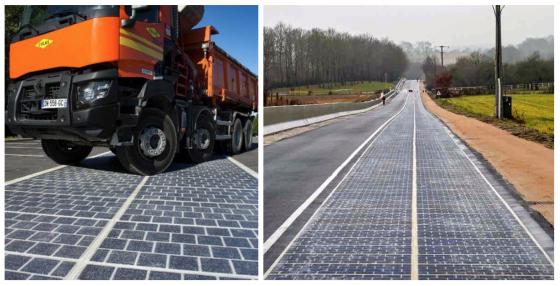Green Building Community
Solar Roadways: Sensational Breakthrough, or Have We Considered this Fully?
Posted by: Ian S.D.

The Missouri State Department of Transportation (MoDOT) recently unveiled plans to develop solar roadways on Historic Route 66. The plans are part of MoDOT’s “Road to Tomorrow” initiative: a broad, multifaceted initiative to improve Missouri’s transportation system with advanced technology. MoDOT has already discussed plans to implement smart pavement and vehicle connection networks, and solar roadways is just the newest innovation added to Road to Tomorrow. Essentially, the technology involves installing hexagonal solar panels attached together to form a roadway that people can walk, bike, or drive on. This structure takes advantage of all the sunlight which usually heats up the roadways and puts it to good use. The technology itself is still in its infancy in terms of real-world application, but MoDOT has decided to give it a trial run by installing a 12x20 foot patch of panels on a sidewalk leading up to the main entrance of the Historic Route 66 Welcome Center in Conway, MO (EcoWatch). This prospect is certainly exciting, but in order to further explore the limits of this technology, we must go back to its inception.
In May of 2014, Scott and Julie Brusaw, a married couple of engineers living in Idaho, started an indiegogo campaign by publishing a video titled “Solar FREAKIN Roadways!”. In the video (which can be seen here: https://www.youtube.com/watch?v=qlTA3rnpgzU), the many potential benefits of roadways composed of solar panels are pitched in a very energetic and sensational manner, touting the technology as reminiscent of “TRON” and emphasizing the cool new features these panels could provide.
First off, there is the fact that these are, as the video so aptly puts it, solar FREAKIN roadways. Replacing the road with solar panels would allow us to generate billions of kWh worth of solar energy. Brusaw estimates that if every road in the US was a solar road, we would produce three times the energy we do now. These energy gains are not to be scoffed at, and as with any new technology, implementation and maintenance could help create new jobs for workers, providing a stimulus to the economy in areas with a lot of roadway. If implemented correctly, these green advancements could lead the entire US into a new era of cleaner energy.
Second, these solar panels are electrical devices, and this opens up dozens of possibilities. LED lights could be installed in and powered by the solar panels, and configured to create road markings. No longer will we need to repaint lane markers, or even change them if a detour is ahead. We might even be able to signal drivers about upcoming hazards such as animals crossing the road. Additionally, the panels are heated by their own energy. This allows them to never accumulate snow or ice, as the temperature can always be kept above freezing. These roads will theoretically never need to be plowed, which will make driving on them much safer.
There are clearly many benefits, and the video explains them in a very exciting way. This sensational approach contributed to the video’s viral spread around the internet. To date, over 21 million people have watched it, and many have donated to its indiegogo fund, making it the most funded indiegogo project in history. However, there were many criticisms of the new technology, and many claimed that it would never work when implemented in the real world.
The first concern which is often raised is how these glass encased solar panels will function as a road. Driving on glass is obviously very different from driving on asphalt as we are accustomed to, and although Brusaw claims that the roadways have passed traction tests with vehicles, he hasn’t stress tested any of these claims. This essentially means that we have not tested how cars would perform if they had to slam on the brakes quickly, or how heavier vehicles such as semi trucks would fare on the roads. This is significant, because this is how the majority of accidents happen, and if vehicles behave differently on these glass roads when they are in dangerous situations, they could cause increased destruction of property and loss of life. Then there is also the concern that when being used as roads, the glass will degrade due to dirt erosion and cars repeatedly driving over them. In addition to being able to support vehicles and give them enough traction to be safe, to prevent degradation the glass must also be tempered, self cleaning, and able to transmit enough light to the photovoltaics beneath it to generate energy. This is very advanced technology, and glass like this does not yet exist (Scientific American).
In addition to the concerns about the solar roadway functioning as a road, there are also concerns about the solar roadway functioning as solar panels. Many people have pointed out that putting solar panels underneath something (in this case, vehicles) will hurt the output of the solar panels. It may seem like single vehicles driving over them would have no impact, but according to Petite Planete founder Craig Morris, “shading is a major issue with photovoltaics. A single pole – an antenna, for instance – casting a shadow across an array can ruin its output”. In photovoltaics, the current generated is only as strong as the weakest cell in the array, and “if one cell is not producing much current (such as when it is shaded), it reduces the entire output of the string”(Renewables International). If something that small can drastically reduce the output of the panels, imagine if there were a larger obstruction, such as a traffic jam. Shading like this could stop photovoltaic production, and this would render the solar panels useless.
This brings up another problem, in that without consistent output, these solar panels are very inefficient. The LED’s and heating that were mentioned earlier are fantastically useful features, but they use power, and a great deal of power at that. If the roadway isn’t producing energy for some reason; maybe there is a traffic jam shading the roadway, or maybe it's simply a cloudy day, the roadway will consume energy rather than produce it. At present, the design for the solar roadways has the heaters drawing energy from the grid specifically for this reason, so that they can continue to run in case of low photovoltaic production. However, some critics estimate that the energy required to hook the heaters up to the grid 24/7 will outweigh the energy that the solar panels could generate themselves.
The last major criticism of solar roadways is that there are simply better ways to generate solar power, including putting solar panels on top of parking lots and on the side of the road. Morris argues that we already have the necessary technology to make solar energy viable without solar roadways, and that our insistence on these sensational breakthroughs is causing us to neglect the solar technology that already exists. “The future has already started”, claims Morris, “and we don’t need to wait for something ‘cool’ to come along”(Renewables International). The technology for solar energy has improved incrementally for years but has not gained a foothold in the energy market. Many argue that the reason for this is because the public and policymakers have not been giving solar the popular and legal support it needs to really take off.
Maybe, as Morris argues, continuing to insist on these kinds of breakthroughs will leave us always waiting for the next breakthrough and never supporting solar properly. Or maybe instead, solar roadways will be the breakthrough we need to support solar and get the technology implemented around the world. Only time will tell, and we will get our first taste of this new technology on Route 66. What do you think? Leave comments below!
Sources:
http://www.ecowatch.com/nations-first-solar-roadway-coming-to-historic-route-66-1891182977.html
http://www.modot.org/road2tomorrow/
http://thenextweb.com/insider/2016/06/23/missouri-experiment-power-unlikely-source-roads/
http://blogs.scientificamerican.com/observations/hard-road-ahead-for-solar-freakin-roadways/
http://www.renewablesinternational.net/solar-roadways-needs-to-be-stopped/150/452/79235/
Allison Friedman // Rate It Green Admin
FYI, the first Solar Roadway opened in France this past year - it's called the Wattway: http://bit.ly/2jBHpwr. This article also says there's a project planned for Georgia in the US. So we will soon start learning how the technology is working out.
Please be kind and respectful!
Please make sure to be respectful of the organizations and companies, and other Rate It Green members that make up our community. We welcome praise and advice and even criticism but all posted content and ratings should be constructive in nature. For guidance on what constitutes suitable content on the Rate It Green site, please refer to the User Agreement and Site Rules.
The opinions, comments, ratings and all content posted by member on the Rate It Green website are the comments and opinions of the individual members who posts them only and do not necessarily reflect the views or policies or policies of Rate It Green. Rate It Green Team Members will monitor posted content for unsuitable content, but we also ask for the participation of community members in helping to keep the site a comfortable and open public forum of ideas. Please email all questions and concerns to admin@rateitgreen.com


